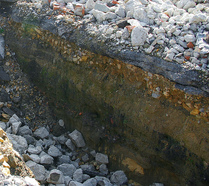Subsurface sampling is an important field task during a environmental site investigation. Whether exploring for resources, testing for geotechnical data, or determining the extent of contamination, soil sampling provides materials for evaluation, testing and analysis. Continuous sampling using one of several drilling methods can be a good investigation choice. Advantages and disadvantages of continuous sampling should be evaluated and penciled out to help you meet project data and cost objectives.
What Is Continuous Sampling?
Continuous sampling is simply drilling through soil or rock and obtaining an uninterrupted length of sample. The continuous sample can be subsampled for chemical analysis, thin sections, assay testing or for continuous description of subsurface materials.
What Are Continuous Sampling Drilling Methods?
For soil, push probe, auger, rotary, sonic, and the old standard cable tool are most common. Continuous samples can be obtained in plastic sleeves or core barrels in lengths of five to twenty feet. Back-to-back sampling can also achieve continuous coring, for example, using a continuous split spoon with hollow stem auger drilling. For rock, the most common methods are rotary and sonic. Rotary methods can obtain continuous rock core of different diameters lengths of five feet or more.
What Are Advantages And Disadvantages Of Continuous Sampling?
Descriptive Borehole Log: allows a complete record of the subsurface to identify fine features like a landslide failure plane or 6-inch permeable zone. This may be a geologists’ first choice, but depending on your project needs this can be a case of too much information.
Sample Collection: allows a holistic view of the subsurface for field tests or strategic subsampling for chemical analysis. Continuous sampling may not be useful for some material tests, which require undisturbed samples and may require special collection such as Shelby tubes.
Cost: more time is needed to manage samples, increasing the project cost, especially if specialized samples are needed that may require a second borehole.
Investigative Derived Waste (IDW) Management: total volume of IDW may be the same for continuous or targeted sampling but there may be differences in IDW management and disposal. For example, mud in a recycle pit may be disposed in place whereas extra soil core needs to be drummed.
Wet versus Dry Coring: dry coring is useful above the water table if borehole walls are stable but can overheat the sample and change its chemistry or texture. Wet coring helps remove cuttings from the borehole but can contaminate samples with mud or other contaminants present in the subsurface.
Talon/LPE has completed hundreds of borings using a variety of continuous coring methods. Contact our experienced professionals today to get answers for all your drilling and sampling questions. We provide environmental drilling services throughout Texas, Oklahoma, New Mexico and Louisiana.
What Is Continuous Sampling?
Continuous sampling is simply drilling through soil or rock and obtaining an uninterrupted length of sample. The continuous sample can be subsampled for chemical analysis, thin sections, assay testing or for continuous description of subsurface materials.
What Are Continuous Sampling Drilling Methods?
For soil, push probe, auger, rotary, sonic, and the old standard cable tool are most common. Continuous samples can be obtained in plastic sleeves or core barrels in lengths of five to twenty feet. Back-to-back sampling can also achieve continuous coring, for example, using a continuous split spoon with hollow stem auger drilling. For rock, the most common methods are rotary and sonic. Rotary methods can obtain continuous rock core of different diameters lengths of five feet or more.
What Are Advantages And Disadvantages Of Continuous Sampling?
Descriptive Borehole Log: allows a complete record of the subsurface to identify fine features like a landslide failure plane or 6-inch permeable zone. This may be a geologists’ first choice, but depending on your project needs this can be a case of too much information.
Sample Collection: allows a holistic view of the subsurface for field tests or strategic subsampling for chemical analysis. Continuous sampling may not be useful for some material tests, which require undisturbed samples and may require special collection such as Shelby tubes.
Cost: more time is needed to manage samples, increasing the project cost, especially if specialized samples are needed that may require a second borehole.
Investigative Derived Waste (IDW) Management: total volume of IDW may be the same for continuous or targeted sampling but there may be differences in IDW management and disposal. For example, mud in a recycle pit may be disposed in place whereas extra soil core needs to be drummed.
Wet versus Dry Coring: dry coring is useful above the water table if borehole walls are stable but can overheat the sample and change its chemistry or texture. Wet coring helps remove cuttings from the borehole but can contaminate samples with mud or other contaminants present in the subsurface.
Talon/LPE has completed hundreds of borings using a variety of continuous coring methods. Contact our experienced professionals today to get answers for all your drilling and sampling questions. We provide environmental drilling services throughout Texas, Oklahoma, New Mexico and Louisiana.


